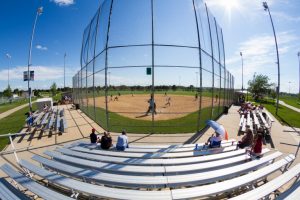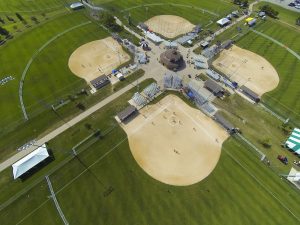Private-public partnership key to sports complex in Bloomington/Normal
By Dave Fidlin for Chronicle Media — August 10, 2018
Champion Fields at Maxwell Parks in Bloomington features fields for various sports such as soccer and softball. (Photo courtesy of visitbloomingtonnormal.org)
While more questions than answers continue to hang in the balance, a consultant’s recent study on a proposed regionally focused multi-purpose sports complex likely would not succeed without a public-private partnership
The primary reason: cost. Depending where exactly such an amenity is perched in Bloomington or Normal, it could cost in the ballpark of $43.58 million, according to estimates.
In April, the Normal Town and Bloomington City councils enlisted the services of Sports Facilities Advisory Group, a Clearwater, Fla.-based company that provides municipalities with market-specific conditions for recreational amenities.
In the ensuing months, SFAG staffers undertook a number of efforts before delivering a report to municipal officials and offering up a litany of recommendations.
Last month, Evan Eleff, chief operating officer with SFAG, ventured to Central Illinois and offered up key points from his company’s findings. The biggest takeaway, Eleff said, is a belief there is support across the community for such an amenity, based on responses the company received.
While a multi-sport complex would likely host locally focused programs offered through Bloomington and Normal’s parks and recreation departments, Eleff said the amenity also has the potential serving as a regional draw.
Nationally, Eleff said the trend of sports tourism has been on the uptick, and he said he does not foresee it ending anytime soon.
Talk of creating a dedicated sports arena began to percolate when the future of a soccer field near the Central Illinois Regional Airport became murky. The land used for the soccer fields could be redeveloped into other purposes in the future.

Aerial view of Champion Fields at Maxwell Parks in Bloomington. (Photo courtesy of visitbloomingtonnormal.org)
Despite the initial motivator, Eleff in his presentation to the dual councils last month cautioned a wide net has to be cast for the multi-sport complex to be successful.
“It can’t just be about soccer or a single sport,” Eleff said. “Multi-purpose is absolutely key — not just looking at a single sport.”
Another point Eleff emphasized throughout his recent presentation to local officials is the need to bring at least one private entity into the fold so the facility is not fully taxpayer supported.
“This can’t be a long-term (tax) burden,” Eleff said. “That means it has to sustainable for the community. It’s got to affordable in the community.”
Of private partnership exploration, Eleff said, “We would welcome that as a next step. Look for those public-private partnerships.”
Chris Koos and Tari Renner, mayors of Normal and Bloomington, respectively, have echoed similar sentiments about the feasibility of the sports complex in recent months. Efforts of trying to secure partnerships reportedly are underway.

The Sports Facilities Advisory group works with municipalities to help customize sports complexes for their community needs. The group met recently with representatives from Bloomington and Normal to talk about a new complex serving the region and as a sports tourist site.
The $43.58 million cost estimate Eleff presented last month to Bloomington and Normal officials is considered at the high end of the cost projection spectrum. Factors that could fluctuate the figure include a determination into whether the facility would be indoor or outdoor.
Eleff in his presentation provided recommendations on both prospects. If an indoor facility were pursued, Eleff said a dome-type facility would be optimal.
“(It) allows a lot of flexibility,” Eleff said. “It costs an awful lot less to build on the front end.”
Alternatively, if an outdoor option were chosen, Eleff said the region with a field primarily made of synthetic turf with a small intermingling of natural fields.
Another big question mark at present is where exactly the complex would be housed. The good news, from Eleff’s vantage point, is the vast availability of land in and near Bloomington and Normal’s limits.
“There are a large number of sites that could house a complex,” Eleff said.
From his professional expertise, Eleff also offered local elected leaders a few parting words of advice about the heavy, long-term lifting required to ensure the amenity is a success. Similar projects elsewhere have succeeded, he said, through such efforts as marketing and planning well in advance of the doors opening.
“You can’t build it, cut the ribbon and expect it to be up and running,” Eleff said.
Bloomington and Normal’s municipal leaders are expected to continue discussing the proposal in the months ahead, and further announcements about the project’s direction could surface before the year winds to a close.



